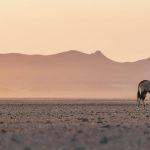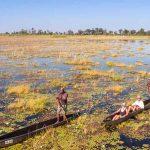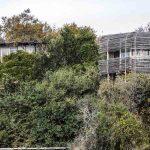Africa makes sense of all that ecology-biodiversity-sustainable-habitat stuff that sounds so like the special pleading of socially inept, bearded weirdies when applied to a field in back-garden Britain. Here it has the depth and grace of a religious conviction.
The Serengeti: under the lowering anvil nimbus, electric storms stutter on the horizon. The shimmering burnt-orange African sun plummets; a hot wind sways the social weavers’ intricately constructed nests in the whistling thorn. The heavy air vibrates with cooing of doves and the creaking-gate single note of the tropical boubou. High above, a pair of bateleur eagles catching a lazy late thermal precariously balance like their eponymous tightrope walkers. And over the undulating dry surf of grassland the game teems.
It teems and it teems. It teems from left to right and from right to left. It teems up and it teems down and it teems round and round until you are dizzy with teeming. Will this damn teeming never stop? The Serengeti game is divided into two teams: those that eat and those that are eaten. It is one enormous game of kiss- chase with biting. If you only know Africa you know. This is Attenborough country. The gnarly buzzcut acacias, the purple sky, the oily, pustulant sun that slides across the horizon, truncating the evening into 20 minutes of the most exotically beautiful light on earth.
The Serengeti stretches from northern Tanzania across the border into Kenya. This is where the annual migration of wildebeest takes place. Animals following the rains, pulling all the mint-sauce teams behind them. Wildebeest are God’s extras. Individually, they are odd, humpy creatures with long, mournful faces that seem to be continually muttering “Nobody knows the trouble I seen” under their breaths; collectively on the move at a stiff-legged canter, they are one of the great wonders of the world, making the Serengeti Cecil B De Mille Africa. A wildebeest’s only defence against the cruel market forces of a carnivorous world is statistics. There are so many of us, chances are it won’t be me. They even arrange to calve all at the same time in the same place, providing the lions and hyenas with the largest canapé smorgasbord in the world. Wildebeest are nature’s proof that communism works. It’s just not much fun. Their bones litter the plains.
The great grey-green greasy Grumeti river, all set about with fever trees, runs through the heart of the Serengeti. It is home to turgid pods of hippo and crocodile you could land small planes on. Each big enough to make a set of luggage that would comfortably take Joan Collins on a world cruise. Hippos look and sound like the House of Commons. Fat, self-satisfied gents with patronising smirks and fierce pink short-sighted eyes in wrinkled grey suits going “haw-haw” and telling each other dirty jokes. They sit like backbenchers in their soupy tearooms and defecate copiously, lifting their vast buttocks out of the water and spinning their tails like Magimixes. At night you lie awake and listen to them chunter and canvass outside the tent.
The Ngorongoro crater is other place you’ll know if you’ve only been to Africa by armchair. Seven thousand feet up, it is a volcano crater with more microclimates than you can shake a meteorologist at. A perfect soup bowl of game. In fact, Ngorongoro is Africa’s Mount Olympus of game. Purists with breath you could use for snakebite serum of the Outward Bound knit-your-own-bullet school tend to roll their malarial yellow eyes and harrumph like warthog farts at the mention of Ngorongoro, bellowing that it is Disneyland Soho on a Saturday night, St Tropez in July. And they have a point. It is the beaten trail. But then, imagine a life lived never having seen Disneyland or Soho or St Tropez and double it and double it again. The Ngorongoro crater fair takes your breath away. It is a spectacle. It makes The Lion King look like a song and dance. This is the real thing.
You will see a lot of other Toyota safari trucks. But the view at sunrise from Crater Lodge perched on the lip of the Volcano silences all criticism. And visitors too are a part of a safari’s rich ecology. Crater Lodge looks like Portmeirion designed by Danny La Rue and Puccini. A fabulously camp camp, a collection of individual ethnic petit palaces on stilts, where you get your own butler, savanna beds, a log fire and rose petals in your bath. It is the natural home of one of Africa’s most ubiquitous and photographed denizens, the honeymoon couple. I could sit and watch honeymooners for hours. They are endlessly fascinating and rewarding. The main reward being that I will never ever have to be on one of them again. Africa is perfect postnuptial ecosystem. It has danger, nature, adventure and the Tiffany of night skies. All the subliminal triggers for a really good “Me Tarzan, You Jane” sex life. For newlyweds, this is as good as having sex gets. A brief two weeks of libidinous malaria (sweating and shaking). Nothing in the world makes you feel younger, more alive, more fecund and vigorously, expansively free than other people’s honeymoon in Africa.
The problem, and it is a problem with safaris, is that many tourists get to see Africa, experience Africa, fire off enough film to garland an amphitheatre to prove that they’ve done Africa, but never actually set foot in Africa. They set from camp/lodge to converted long-wheelbased Land Rover without ever getting dust on their new Gore-Tex safari boots. Viewed from a truck, it is all as real and special and awe-inducing as most north-world people could ever want.
But looking through a window frame stutters the image into being a sort of stamp-collecting. You go in search of things: the big five (lion, elephant, leopard, rhino and Cape buffalo), a kill, a view. You find yourself asking endless questions like “What’s the gestation period of a Thompson gazelle?” “How far in kilometres will a hyena walk at night?” as if you are swotting for a Third World pub quiz. You record and tick things off in the anecdote album. Getting out and walking is a whole other thing altogether, the snapshots allied into a great rolling panorama. You stop being an invisible, omnipotent observer and take your place as apart of it. Both watcher and watched stalker and stalked. Meet it eye to eye. Danger is a big part of Africa’s turn-on. Travellers love travellers’ tales. The most commonly asked question is “Will it eat me?” And the guides have endless routines of blood-clotting stories. It’s all fun, but it misses the point. In the wildebeest’s statistics of danger, Africa is no more risky than most cities at night. “Will that bus eat me?” “Yes, if you stand in front of it.”
You either get the point of Africa or you don’t. What draws me back year after year is that it’s like seeing the world with the lid off. You can see the works, the intricate engineering, that fantastically complex and beautiful series of cogs and wheels and springs and checks and balances that makes the globe work. Africa makes sense of all that ecology-biodiversity-sustainable-habitat stuff that sounds so like the special pleading of socially inept, bearded weirdies when applied to a field in back-garden Britain. Here it has the depth and grace of a religious conviction.
So if you want to walk, you must, simply must go to the Selous, an area the size of Denmark, the largest untouched reserve in the world, named after the greatest of all white hunters a mythic figure who was the basis for Allan Quartermain. It is a vast area of thorn and cliff and sand and jungle, bisected and filigreed by the Rufiji river that runs through sand and cuts a new course after the rains every year, leaving behind lakes and deep gorges fringed with doum palms. Here is the world’s largest collection of hippo, of crocodile and elephant. It is home to some of the last wild black rhino and the biggest packs of wild dog.
Seen from the Sand Rivers camp on a bluff of sandstone, the river glides through a view that remains perfect and pristine for a decade of million years. You can camp out under mosquito nets on a dry river bed and listen to the great game being played out in the inky shadows, thrown by a moon as bright as a Wembley floodlight. You can count shooting stars around the ironwood fire. You can travel up rapids on little flat-bottomed boats, being chased by bull hippos like furious tugs, and cast for fearsomely aggressive tiger fish while watching for crocodiles, being both fisherman and bait. Or walk quietly and with the pounding heart of a peeping tom to watch elephants bathing. You can be one of the pitifully few people who have ever seen wild dog, the painted wolves of Africa, dappled patchwork resting in the shade of an acacia. Don’t think of any of this as frightening. It’s exciting. And if this all sounds like Mills & Boon travel writing, then I make no apology. I don’t know how to impart enthusiasm other than enthusiastically. But if you imagine it’s all too purple to be true, then fine. Stay at home. Nobody would be happier than me.
For westerners, Africa is a place that happens despite Africans. In all the yearning literature this place has spawned, the only indigenous characters are servants and bearers and extras – and that’s shaming. This is the one continent where travellers rarely say they want to meet the natives. Africans themselves spend precious little time enjoying or worrying about their game. The only giraffe most of them have time to care about is on their banknotes. But Tanzania in particular is a fantastically friendly and interesting human place, lively and complex. To come here and see only wilderness and animals is to see only half the story. In one-street towns there is an entrepreneurial imagination and energy that beggars Silicon Valley.
Stone Town is main town of Zanzibar, the Muslim island that was the centre of the Arab slave trade. Zanzibar is the island of cloves and ivory and it is where Livingstone and the other Victorian explorers began their treks into the mapless nothing. Built out of coral, the winding streets and courtyarded houses feel more North African than sub-Saharan. I sat in the English church that was built on the old slave market with the alter directly above its whipping post and listened to Anglican evensong in Swahili, “The Old Rugged Cross” sung with that unmistakeable mournful, soft sound of African voices.
Mnemba Island, off the coast of Zanzibar, isn’t actually Africa at all. It belongs to that other world of travel-brochure covers. I have never been anywhere that so completely encompasses every dream of the perfect desert island. You can walk round it in 20 minutes. It has just ten huts hidden in jungle. There is a bar and frankly miraculous food served on the beach by candlelight. It is always in the sunny 90s, but the coral-white sand never gets hot. The sea is the colour of Paul Newman’s eyes, and there is a reef within doggy-paddling distance. Nothing in the place stings or bites, and there are more laid-back staff than punters. All you ever wear is a kukoi, a sort of gown-up’s nappy. Indeed you regress into it.
After flopping about three days, I’d unstressed into a five-year-old. I became gurgling, smiley, supine, oily lump of wants and simple desires, moving from sun to shade like a happy, nutbrown maggot. Snorkelling over tropical coral reef is exactly like watching the cartoon channel with the sound turned down. Weightless, intellectually neutral colour and movement. In the other huts the sated honeymooners done Tarzanning in the bush lazily played mummies and daddies. In the eaves, doves’ coos beat the intro over and over. The tune preyed in the back of my memory. What was it? “The Mighty Quinn”? No. “Here We Go round the Mulberry Bush”? No. Finally I got it. It was “Swinging Safari”.





